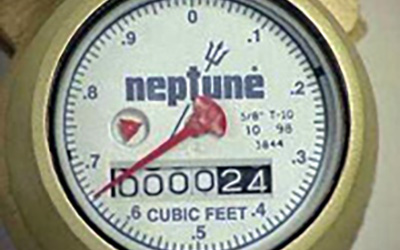Checking For Leaks

HOW TO USE YOU WATER METER TO CHECK FOR LEAKS
Undetected leaks can be costly. Your water meter can tell you how much water you use in a day, week or a month. It can also help you measure the effectiveness of your household’s water conservation program and help detect leaks.
Whether inside or outside your home a leak can waste hundreds of gallons of water per year. Some leaks are easy to see or hear. Others are small. However, big or small, any leak cost you money and should be repaired as soon as possible.
How to locate your meter
Your water meter should be located in front of your house, inside a concrete or plastic meter box that is set flush with the ground. Look for your meter behind the sidewalk at a side lot line near the street. If your home is on a corner lot, your water meter could be located either on the front or side street. Sometimes, meter boxes are not easily visible due to landscaping and other obstructions.
How to read your meter
Reading your water meter is like reading the odometer in your car. Read all the numbers from left to right that appear under the words “cubic feet”.
The first digit on the right represents one cubic foot. The second from the right represents 10 cubic feet. The third from the right (usually a different color) represents 100 cubic feet – or one ccf. One revolution of the meter sweep-hand equals one cubic foot, or 7.48 gallons.
Checking your system for leaks
There is a simple test you can perform to use your water meter to detect leaks. First, turn off all your faucets and water-using appliances (such as dish and clothes washers) and be sure no one is using any water. Then go to your water meter and lift the cover of the meter dial. Note the position of the sweep-hand by using a piece of tape, or by using a marker on the lens cover.
Then, wait 20-30 minutes and check the sweep-hand location again. If the sweep-hand has moved, you probably have a leak somewhere in your system. If the small red diamond shaped indicator on the face of the meter is moving, it also means you probably have a leak. Retest to be certain; then locate the leak by inspecting all the pipes, fixtures and appliances that use water. Click here to view an easy step by step video on how to find water leaks at your home.
Where to look for leaks
* Your toilet may have a silent leak. Drop a little food coloring in the tank. Wait about 10 minutes without flushing. If color appears in the bowl you have a leak.
* Check for moist spots around and under house plumbing and around the outdoor plumbing.
* Replace worn washers in faucets and showerheads. A little drip waste many gallons each day.
![]()
Conservation Rebates
![]()
Conservation Tools
![]()
Indoor Conservation
![]()
Outdoor Conservation
![]()
